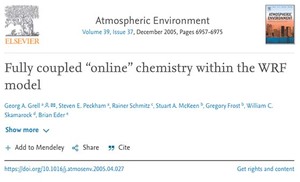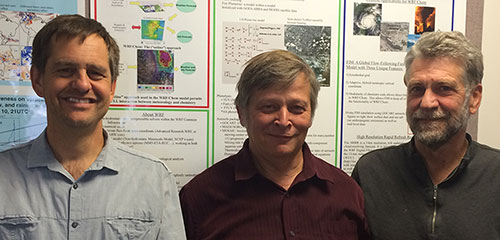GSL and CSL paper identified as a top ten paper that has influenced the field of tropospheric chemistry


A 2005 paper published in Elsevier’s Atmospheric Environment was identified as one of the top ten papers that has influenced the field of tropospheric chemistry. The paper, “A fully coupled “online” Weather Research and Forecasting/Chemistry model” was authored by Georg Grell (GSL), Steven Peckham (CIRES), CSL’s Stuart McKeen and Greg Frost, Brian Eder (ARL), William Skamarock (NCAR), and others. The article has 1332 citations on Web of Science and 1436 on Scopus (dated March 27, 2020).
The statement comes from “Papers that shaped tropospheric chemistry”, an opinion letter published in the European Geophysical Union’s Atmospheric Chemistry and Physics journal.
The Grell et. al publication discusses how the simulation and prediction of meteorological factors such as wind speed and direction, turbulence, radiation, clouds, and precipitation, influence the prediction of air quality with an online coupled modeling system. Historically, chemical transport modeling systems treated air quality and meteorology independently, known as "offline."
In the paper, the researchers describe how they integrated chemical processes into the existing Weather Research and Forecasting (WRF) model making it fully coupled and "online." The "WRF-Chem" air quality and meteorological components are consistent with each other and use the same transport scheme, the same grid, and the same physics schemes for subgrid-scale transport.
The 2005 paper also compared the WRF-Chem Model output with previous chemistry models and found it to be just as accurate in predicting photochemistry and emissions as previous models while providing better forecasts of ozone and ozone precursors. Since the paper's publication in 2005, the WRF-Chem model has become the standard for research in air quality as well as research on impacts of aerosol and chemistry on numerical weather prediction. WRF-Chem is now a community model – support provided by GSD – and has more than 2000 users worldwide.
This paper was also awarded the 2016 Haagen Smit prize. The international Haagen-Smit Prize recognizes outstanding papers published in the Elsevier journal Atmospheric Environment. The fact that their paper was published in 2005 and was selected for this prestigious prize in 2016 shows its long-term influence in the field.
